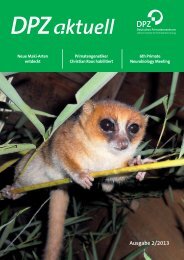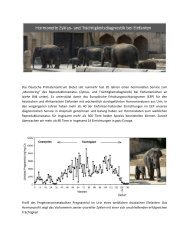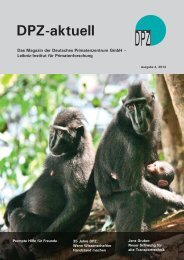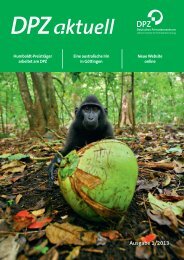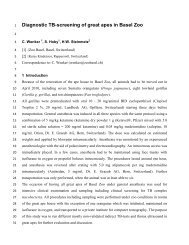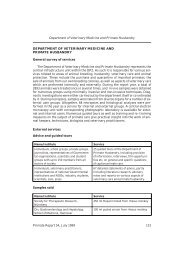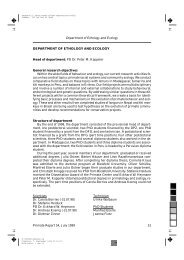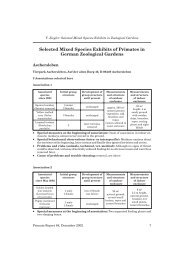Vol. 15 - Deutsches Primatenzentrum
Vol. 15 - Deutsches Primatenzentrum
Vol. 15 - Deutsches Primatenzentrum
You also want an ePaper? Increase the reach of your titles
YUMPU automatically turns print PDFs into web optimized ePapers that Google loves.
Lemur News <strong>Vol</strong>. <strong>15</strong>, 2010 Page 23<br />
countered in such "virgin" internodes support this hypothesis.Reasons<br />
for this might either be a search for drinking water,<br />
or the search and detection of insect larvae which develop<br />
inside these internodes and which have not yet made a<br />
hole to emerge.<br />
(4) As a fourth and highly speculative hypothesis, the aye-aye<br />
may gnaw holes into "virgin" bamboo segments (or increase<br />
the size of pre-existing holes) as part of a long-term feeding<br />
strategy in which such holes are produced to make the bamboo<br />
segment suitable for colonization by arthropods and<br />
frogs. This would enable the aye-aye to "harvest" its food<br />
during a subsequent visit to the site several days later. Obviously,<br />
such a foresighted feeding strategy in a basal primate<br />
would be of extreme interest,but we are aware that alternative<br />
and more probable explanations exist.<br />
Detailed testing of these hypotheses will require long-term<br />
observations in an area of dense growth of large bamboo,<br />
probably including the deployment of a large number of camera<br />
traps and possibly hair traps to obtain evidence of aye-aye<br />
activity. Carrying out such studies at the site in Matsabory<br />
Maiky is difficult. It should be noted that the Tsaratanana<br />
massif is difficult to access. However, alternative sites, e.g. at<br />
Marojejy (Duckworth, 1993) might contain a large population<br />
of Platypelis (albeit other species) as well, and could be<br />
surveyed more systematically.<br />
Acknowledgements<br />
A warm thanks to the Directorate of Waters and Forests<br />
and the Head of the Offices of Madagascar National Parks at<br />
Mangindrano and Ambanja for the research permits on<br />
Tsaratanana. We are also indebted to the many people who<br />
have logistically assisted in our expedition, especially to the<br />
local guides (Faly and Levaovao) from Mangindrano.<br />
References<br />
Delobel, A.; Tran, M. 1993. Les coléoptères des denrées alimentaires<br />
entreposées dans les regions chaudes. Faune<br />
tropical XXXII: 98-99.<br />
Duckworth,J.W.1992.Feeding damage left in bamboos,probably<br />
by aye-ayes (Daubentonia madagascariensis).International<br />
Journal of Primatology 14: 927-931.<br />
Erickson, C.J. 1994. Tap-scanning and extractive foraging in<br />
aye-ayes, Daubentonia madagascariensis. Folia Primatologica<br />
62: 125-135.<br />
Erickson, C.J. 1995a. Feeding sites for extractive foraging by<br />
the aye-aye,Daubentonia madagascariensis.American Journal<br />
of Primatology 35: 235-240.<br />
Goix,E.1993.L’utilisation de la main chez le aye-aye en captivité<br />
(Daubentonia madagascariensis) (Prosimiens, Daubentoniidés).<br />
Mammalia 57: 171-188.<br />
Milliken,G.W.;Ward,J.P.;Erickson,C.J.1991.Independent digit<br />
control in foraging by the aye-aye (Daubentonia madagascariensis).<br />
Folia Primatologica 56: 219-224.<br />
Simon,E.L.;Meyer,D.,2001.Folklore and beliefs about the aye<br />
aye (Daubentonia madagascarienis) Lemur News 6:11-16.<br />
Discovery of crowned sifaka (Propithecus<br />
coronatus) in Dabolava, Miandrivazo, Menabe<br />
Region<br />
Josia Razafindramanana 1*, Rija Rasamimanana 2<br />
1Groupe d’Etude et de Recherche sur les Primates de Madagascar<br />
(GERP), Lot 34 Cité des Professeurs Fort Duchesne,<br />
Ankatso, Antananarivo 101, Madagascar.<br />
2Pan African Mining Madagascar (PAMM), Lot 137 II AN<br />
Analamahitsy, Antananarivo 101, Madagascar.<br />
*Corresponding author: r_josia@hotmail.com<br />
Key words: Propithecus coronatus, Dabolava, distribution,<br />
lemurs, Indridae<br />
The crowned sifaka Propithecus coronatus was until recently<br />
regarded as one of four subspecies of P. verreauxi, family<br />
Indridae, which occur throughout western and southern<br />
Madagascar (Muller et al., 2000; Mittermeier et al., 1994; Tattersall,<br />
1986; Wilmé and Callmander, 2006). Recent taxonomic<br />
revisions (Mittermeier et al., 2008) have promoted all<br />
four subspecies to full species status (Mittermeier et al.,<br />
2006). However, there is considerable debate about the validity<br />
of P. coronatus, and especially its relationship with P.<br />
deckeni (Mittermeier et al.,2008),due to the physical similarities<br />
and close geographical distributions of these taxa,including<br />
apparent sympatry at some sites (e.g. Tattersall, 1986;<br />
Curtis et al.,1998;Muller et al.,2000;Groves,2001;Thalmann<br />
et al., 2002).<br />
P. coronatus was previously assigned to the IUCN conservation<br />
rating "Critically Endangered",but has since been moved<br />
into the "Endangered" category; nevertheless, the distribution<br />
range and the ecology of this species are not yet well<br />
understood (IUCN, 2008). Crowned sifakas are diurnal, and<br />
their habitat is characterised by dry deciduous forests and<br />
mangroves (Petter and Andriatsarafara, 1987). They live in<br />
groups of two to eight individuals, with home ranges from<br />
1.2–1.5 ha.They feed mainly on buds,green fruits and mature<br />
leaves (Muller,1997).It is known that they reproduce seasonally,<br />
with females giving birth every 2-3 years (Curtis et al.,<br />
1998; Mittermeier et al., 2006). Compared to other lemurs,<br />
their reproduction rate is very slow, making recovery of<br />
small populations even more problematic.<br />
The newly discovered crowned sifaka population is situated<br />
at Amboloando (UTM WGS 84,N 7822351 E 580189) in the<br />
Commune of Dabolava in central Madagascar,and is the most<br />
southerly record of the species.Amboloando lies about 4 km<br />
from Dabolava village, and 40 km to the southeast of Miandrivazo.Amboloando<br />
comprises 7 ha of dry semi-deciduous,<br />
secondary forest that exhibits the characteristics of riverine<br />
forests, consisting of deciduous as well as evergreen trees<br />
such as Acacia sp.,Nastus sp.and Macaranga sp.The altitude is<br />
about 600 m above sea level,and the area is characterized by<br />
a clearly defined wet and dry season.The sifaka population is<br />
composed of a single group,which constituted six adults and<br />
one juvenile when first discovered in June 2009 (Razafindramanana,<br />
2009). One of the adult males disappeared later in<br />
the year, presumed dead, leaving six individuals remaining.<br />
The animals appear to be classic P.coronatus (Fig.1),but some<br />
individuals show pelage colour variation, with dark fur on<br />
their back and arms (Fig.2).Behavioural studies of the group<br />
are underway,and a preliminary community-based conservation<br />
program has been established at the site, involving several<br />
organisations including GERP, The Aspinall Foundation,<br />
SAHA and Pan-African Mining Madagascar.Forests in Amboloando<br />
and the surrounding area are heavily degraded. Different<br />
factors threaten the survival of this species in Madagascar:in<br />
contrast to the other sites such as Anjamena (Muller,2000),hunting<br />
does not occur in Amboloando,partly due<br />
to the sifaka being regarded as holy by the local people.<br />
Therefore,other threats such as habitat destruction through<br />
slash-and-burn agriculture to make way for pasture for livestock,charcoal<br />
production,and mining exploitation affect the<br />
sifaka group.<br />
Surveys in the vicinity of Dabolava suggest that this is the<br />
only group of P.coronatus remaining in that area,despite local<br />
people claiming that other groups were present between 5<br />
and 10 years ago. Therefore, it appears that habitat destruc-





